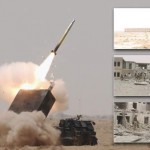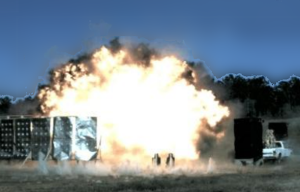
Lockheed Martin has received a $79.4 million contract from the U.S. Department of Defense to develop a new ‘Alternative Warhead’ (AW) for the Guided Multiple Launch Rocket System (GMLRS) that incorporates a new explosive area effector replacing the cluster warheads currently used with the weapon. Under the 36 month Engineering and Manufacturing Development Program awarded by the Army the company will move the developmental system into a producible product and perform type qualification necessary for introducing the new warhead into service.
The original GMLRS was introduced in 2005 as an upgrade to the M26 rocket. At the time it came with a single types of warhead – a cargo bay containing multiple Dual-Purpose Improved Conventional Munition (DPICM) bomblets. However, this type proved ineffective in engaging urban targets, due to lack of penetration capability and the significant hazard of unexploded munitions left after the attack. Responding to the growing demand for heavy, precision firepower supporting urban fighting in Iraq and Afghanistan, the Army introduced a second warhead in 2008, this unitary warhead variant packs a 200-pound class high-explosive charge to provide precision strike blast and fragmentation effects with low collateral damage. However, this type did not provide the area effect of the cluster weapon. As a third type, the GMLRS AW unitary warhead is designed to as a ‘drop-in’ replacement for the currently fielded DPICM cluster warhead which will be phased out in upcoming years, with the 2008 DoD Policy on Cluster Munitions & Unintended Harm to Civilians comes to effect (Toward a Cleaner Battlefield, Defense-Update 2007). The AW rocket will service area target sets without producing unexploded ordnance. The AW will begin fielding in FY16 and is expected to achieve Initial Operational Capability by december 2016.
During live-fire testing by the U.S. Army, the ATK-designed Alternative Warhead demonstrated that it meets performance and mission requirements, reduces technical risk and matches current weapon flight characteristics without major modifications to the existing GMLRS delivery system.
GMLRS is a combat proven, all-weather, precision-guided rocket that provides increased accuracy over statistical artillery and rocket artillery weapons, thus reducing the number of rockets necessary to defeat current targets.

The warhead, developed by ATK is designed to meet or exceed the GMLRS DPICM unexploded ordnance (UXO) requirements, fit within the existing rocket architecture and concept of operations (CONOPS), and meet lethality and insensitive munitions requirements. All these requirements were validated in 2010 when live fire testing was conducted at White Sands Missile Range (WSMR), New Mexico. ATK’s design used innovative components to meet mission requirements, lower technical risk, and
match current warhead flight characteristics with no modifications to the existing delivery system




















